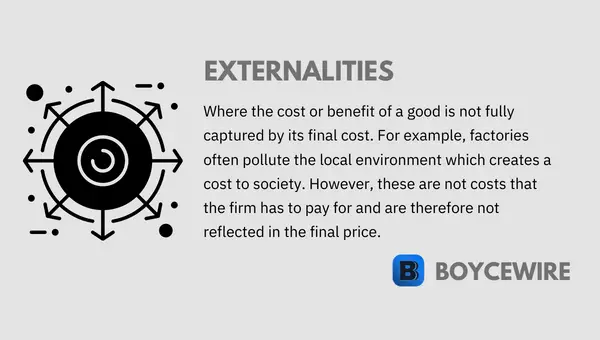Externalities: Definition, Positive & Negative Examples

What Is an Externality?
An externality in economics refers to a cost or benefit that is imposed on a third party and not taken into account in the final cost of a product. The word itself comes from the Latin ‘externus’, meaning ‘outside’ or ‘outward’.
Externalities can take the form of positive or negative effects. Positive externalities create a benefit to a third party, while negative externalities create a cost to a third party. These externalities can occur during both production and consumption.
For example, a company that uses environmentally-friendly production methods creates a positive externality for society, while a company that pollutes the environment creates a negative externality.
Key Points
- An externality is a cost or benefit imposed onto a third party, which is not factored into the final price.
- There are four main types of externalities – positive consumption externalities, positive production externalities, negative consumption externalities, or negative production externalities.
- Externalities create a social cost where goods are undersupplied or create damage to the environment.
Production externalities involve pollution from the manufacturing process, while consumption externalities occur during the use of a product. For instance, smokers can create negative externalities by releasing harmful fumes that can damage the health of those exposed to them.
Positive Externalities
Positive externalities occur when a third party benefits at no direct cost. For example, in a mall with hundreds of shops, a consumer may only visit a few specific shops they want to buy from. Yet other stores may benefit if the consumer goes into more stores than planned, as they can benefit from the popularity of their surrounding stores.
Another example of a positive externality is when new software increases the productivity of a business. When businesses are more productive and efficient, they have lower production costs, which allow them to charge lower prices to consumers. As a result, consumers indirectly benefit from such advances.

Public goods often have positive externalities. A street light is an example of a public good that enhances visibility for both drivers and pedestrians without imposing a direct cost. Additionally, it reduces the risk of accidents, benefiting not only individuals but also insurance companies.
This example highlights how certain goods can benefit multiple third parties. Insurance companies benefit from fewer claims and individuals from a lower risk of accidents. However, quantifying the benefits is difficult, and it is impossible to calculate how much each party has gained.
It is also impossible to predict how many lives have been saved or how much money insurance companies have saved. Therefore, while positive externalities are considered, it is also essential to consider negative externalities.
“Street lights provide drivers and pedestrians with enhanced visibility during the night. Both benefit without a direct cost being imposed on them.”
As with any government spending, it takes money away from private hands and directs this to areas where it sees fit. The external cost is that private firms and individuals have less disposable income. So although positive externalities are created, they are balanced out by potential negative externalities. This is because the private sector has fewer funds in order to be able to invest in productive equipment.
Examples of Positive Externalities
Positive externalities can be split down into two types: production, and consumption. Let us look at some examples of these below.
Examples of Positive Production Externalities
Examples of Positive Consumption Externalities
Positive Production Externalities
Positive production externalities occur when a third party benefits from another’s production without being charged. For instance, a bakery that releases the smell of fresh bread through the mall benefits those in the vicinity, but the baker has no means of charging them.
Some examples include:
1. Local Construction
The construction of new local businesses and other amenities may increase the value of local properties – thereby creating a positive benefit to local residents. They also create jobs that provide income to residents, which can then further stimulate economic activity in the locality. In turn, local residents benefit even if they do not use such a business.
2. New Technology / Process
The advancement of technology has led to private benefits and positive spillover effects. Firms benefit from productivity gains, allowing resources to be spent elsewhere.
For instance, if business A spends $10 million less on producing jumpers, it can be spent on producing a new style of pants or hiring more staff. Such gains would not be possible without the initial productivity gains from technology.
3. Training
A business may train employees with specific skills, resulting in both the business and employee sharing the benefits and productivity gains. However, when the employee leaves, the new employer can benefit from the original training and skills acquired by the previous company.
For example, training in first aid or mental health can provide third parties with the ability to save lives or help individuals outside of the company. Therefore, training can also benefit parties outside the firm.
4. Pharmaceuticals
Pharmaceutical innovation is a contentious issue due to high costs of research and development, as well as risk factors that lead to high prices.
However, there are positive external benefits to this innovation. When a new drug saves a life, it produces a private benefit to the company and the saved individual. Additionally, family and friends no longer have to fear losing a close friend or loved one and experiencing the grief that would result.
Positive Consumption Externalities
A private consumption externality refers to a situation where the consumption of a good or service by one individual affects the well-being of another individual, without either of them being compensated or penalized for it. Let us take some examples:
1. Advertising
When McDonalds, Walmart, or some other big firm advertises, it solves a market failure. For example, it allows services such as Twitter, free-to-air television, and YouTube, remain free. So when you’re watching a YouTube video; you are benefiting from advertisers paying YouTube. Whilst adverts can be annoying, they allow us to view and use such services for free.
2. Education
The procurement of any form of education has the potential to benefit a third party. For example, learning how to read and write at school benefits society as a whole because we communicate more effectively. Without an education, we would not be able to read now, nor would we be able to communicate effectively. For every article or post you read, you are the third party that benefits from that individual’s education.
3. Insurance
Having insurance can create a positive externality. For example, when a third party has their vehicle totaled by a reckless driver, it can create a nightmare situation. There may be $30,000 worth of damages and without the culprit having insurance, they may have to shoulder the cost themselves.
The reckless driver may not have the money to pay for the damages so the third-party has a cost imposed upon them. However, insurance resolves this issue. Should a third party be injured or their car damaged, they can make a claim.
4. Local Investment
Neighbours may invest in their property – developing a new drive or making their house more pleasantly attractive. In turn, this can result in increased market values to third parties in the local area if it makes the area seem more desirable and picturesque.
5. Vaccinations / Personal Hygiene
When we receive vaccinations or take steps to prevent ourselves from contracting a contagious disease, we pass on a benefit to a third party. As a result, we decrease the likelihood of disease from spreading.
Negative Externalities
Negative externalities impose a cost onto a third party without prior knowledge or consent. These externalities occur during an economic transaction between two parties. There are then negative consequences that result, which the third party is not compensated for.
It is said that these negative externalities cause social costs. For example, CO2 contributes to global warming, damage to the environment, and the ozone layer. This is a social cost that is burdened upon all of society. Therefore, the use of CO2 emitting goods creates a negative externality that brings a cost to society. One solution that is frequently cited, is to enforce payment on such individuals or organizations and then redistribute this to the affected parties.
Examples of Negative Externalities
A negative externality is where a cost is imposed onto a third party involuntarily. In turn, governments generally look to step in to resolve such issues. After all, it is hardly fair to have to pay for something that is somebody else’s fault.
These externalities can be split down into production and consumption:
Examples of Negative Production Externalities
Examples of Negative Consumption Externalities
Negative Production Externalities
1. Air pollution
As manufacturers produce cars, televisions, and other goods – they leave Carbon emissions. An example of this was visible in 1952 during ‘The Great Smog of London’. Over the course of 5 days, it is estimated that 6,000 died from air pollution. Obviously this is a very extreme case but is an example of how there can be serious external effects from air pollution.
2. Noise pollution
You may live on a main road, or have noisy neighbours. Either way, a third party cost is imposed upon you through noise pollution. In some studies, this can be associated with increased blood pressure and heart conditions. Obviously a very serious externality.
3. Construction of New Houses
If more houses / apartments are being built in the local area; the value of the surrounding houses will likely take a hit. As there is more supply in the area, existing home-owners may find it less profitable to sell.
Negative Consumption Externalities

1. Smoking and Air Pollution
Slightly different from industrial pollution; smoking is a form of consumption that impacts on a third party. The effects are widely known and can be associated with a higher risk of cancer not only for the individual smoking, but also those inhaling the fumes.
2. Rising Obesity
Higher obesity levels are associated with health conditions such as heart disease. This is a private cost but can impose an additional cost on third parties. As a result, the treatment required has to be paid for, which can come in the form of higher insurance costs; impacting other customers. Or, in government-run systems, it will be paid for by the taxpayer.
3. Litter
After consuming a beverage or food item, the leftover packaging may be thrown on the floor. This creates a cost to the average passer-by in the form an unpleasant sight, as well as the impact on the natural environment.
4. Traffic
In big cities, traffic is a nightmare. People will spend hours of their lives stuck in it. Yet the third-party that pays the cost is other users.
Private vs Social Costs
To understand externalities, it is important to understand the imposed costs. These come in the form of private, social, and external costs.
- A Private Cost is essentially the price paid by a person or firm for a product/service.
- A Social Cost is the sum of the Private Cost in addition to any external costs.
- An External Cost refers to the externalities discussed above. So for example, the cost of air pollution may come to $50, so would be included as an ‘external cost’.
Social Cost = Private Cost + External Cost
Example of Social Cost
A social cost is the sum of a private cost in addition to an external cost (negative externality). The cost to use your car in the morning may by $5. That is the private cost.
There are external costs that include: air pollution, noise pollution, and traffic. Obviously, it is extremely difficult to value such externalities, which makes calculating the total social cost very complex and open to interpretation. Nevertheless, for this example, let us assume these costs amount to $2.50 – that is the external cost. So the overall social cost would be $5 in private costs plus $2.50 in external costs, leading to a total of $7.50.
Social Cost $5 in Petrol + $2.50 in cost of air and noise pollution
Importance of Social Cost
When the social cost exceeds private cost, we have what is commonly known as market failure. This is because all of the total cost is not paid by the customer. So for example, when a plane flies, it causes noise and air pollution. The customer pays for their flight, but there is an external cost imposed on a third party that is not paid for by the customer. This is essentially what carbon emission taxes seek to address.
Externality Solutions
1. Refined Property Rights
When there are refined property rights, all parties are able to negotiate the cost of the externality. For example, an owner of a fishery may be affected by downstream pollution from an industrial firm. The owner of the fishery is able to sue the industrial firm in order to be compensated for the effect it has had on them. In turn, a settlement can be reached to be reimbursed for that negative externality.
2. Taxes
When there are externalities such as pollution, one remedy is to tax them based on units of consumption. For example, a firm that produces 10 thousand tonnes of C02 will be taxed at a rate of $1,000 per tonne. These taxes could then be used to pay for positive externalities such as education and other public goods.
3. Subsidies
Positive externalities are underproduced when the whole social benefit is greater than the private benefit. In such situations, the good is underproduced because private individuals value the good at a lower rate than the overall value it provides to society. One way to resolve this is by offering subsidies and other financial incentives. For instance, many governments offer a ‘green scheme’ to make it more affordable to purchase electric cars.
4. Regulation
Another remedy to address externalities is regulation. By making negative externalities illegal, they may address some of the side effects that occur and reduce its consumption and production. For instance, many countries have now made it illegal to smoke in a public place, which has helped reduce the effects of second-hand smoke.
Related Topics
FAQs
An externality refers to a cost or benefit that is imposed onto a third party. These can come in the form of ‘positive externalities’ or, ‘negative externalities’.
When McDonalds, Walmart, or some other big firm advertises, it solves a market failure. It allows services such as Twitter, free-to-air television, and YouTube to remain free. So when you’re watching a YouTube video; you are benefiting from advertisers paying YouTube. Whilst adverts can be annoying, they allow us to view and use such services for free.
The 4 types of externalities can be split between positive and negative. There are positive production and positive consumption externalities, and there are also negative production and negative consumption externalities.
The cost of externalities is typically borne by the third party that is affected by the activity. This can include individuals, communities, or the environment. However, in some cases, the cost may be borne by the producer or consumer who is responsible for the external effect.
About Paul
Paul Boyce is an economics editor with over 10 years experience in the industry. Currently working as a consultant within the financial services sector, Paul is the CEO and chief editor of BoyceWire. He has written publications for FEE, the Mises Institute, and many others.

Further Reading
 Are Cryptocurrencies Worth the Risk? An Objective Analysis - Table of Contents What is Cryptocurrency What is Cryptocurrency Mining Types of Cryptocurrency How to Buy Cryptocurrency Advantages and Disadvantages…
Are Cryptocurrencies Worth the Risk? An Objective Analysis - Table of Contents What is Cryptocurrency What is Cryptocurrency Mining Types of Cryptocurrency How to Buy Cryptocurrency Advantages and Disadvantages…  Fiscal Policy: Definition, Tools & Objectives - Fiscal policy refers to governments spending and taxation. So how much income it has coming in through taxes, and how…
Fiscal Policy: Definition, Tools & Objectives - Fiscal policy refers to governments spending and taxation. So how much income it has coming in through taxes, and how…  Debt to Equity Ratio - The debt-to-equity ratio is a financial metric that compares a company's total debt to its total equity to assess its…
Debt to Equity Ratio - The debt-to-equity ratio is a financial metric that compares a company's total debt to its total equity to assess its… 

